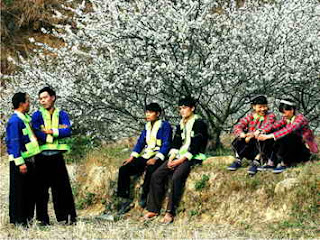Language: The Nung language belongs to the Tay-Thai language group
(Tai-Kadai language family), and is in the same group with the Tay, Thai, and
Choang of China.
History: The majority of the Nung immigrated to Vietnam two or
three centuries ago from Quang Tay, China.
Nung Ethnic Group - Vietnam
ethnic groups
Nung Ethnic Group - Vietnam
ethnic groups
Production activities
The Nung are very good at
cultivating fields. However, because they live on places where wet fields can
not be exploited, they have to work on terraced fields instead. Beside corn and
rice, the Nung also plant some other root vegetables, calabashes, and green
vegetables.
The Nung know how to make many
handicraft products from weaving, metal working, poonah-paper making, and tile
making. Though many of those handicrafts are family traditions, they are still
secondary professions, and done during spare time when there is a break from
farming. Moreover, handicraft products serve mainly family needs. Today, some
of them are diminishing (weaving), and some are preserved and highly developed
(metal working). In Phuc Xen village (Quang Hoa, Cao Bang), many families
practice blacksmithing, and there is at least one person in each family knows
how to hammer well.
Nung makets are highly developed.
They go to fairs to trade, sell, and buy goods. Young people, especially the
Nung Phan Slinh group, like to go to fairs and sing love duets.
Diet: In many regions, the Nung eat mainly corn. Corn is ground
into flour to make thick soup. Foods are fried, stir-fried, or well-cooked, but
seldom boiled. Many people don’t eat water buffalo, beef, or dog meat.
Clothing: The Nung’s traditional clothes are fairly simple, and are
often made from rough, handmade, self-dyed fabrics, and have almost no
embroidery or decorations. Men wear shirts with standing collars, which have
cloth buttons. Women wear long shirts with 5 panels, buttoned up under the
right arm.
Housing: the Nung live in the northeast of the country, and mix in
together with the Tay. They stay mostly in stilt houses. Some live in earthen
houses built with paper or brick walls. In the past, on the border, there were
houses built like a fort with blockhouses and loopholes to prevent and defend
robbers.
Transportation: Traditional ways of transportation are carrying
goods in the arms, on the shoulders, and using shoulder poles. In some places
today, the Nung use carriages with ties or runners, which are pulled by animals
as a mean of transportation.
Social organization: Before August Revolution, Nung society had
developed as much as the Tay’s. Fields and terraces had become private
possessions, and thus could be transferred or sold. Two social classes were
formed: landlords and tenants.
Marriage: Young Nung men and women are free to date and to love.
While dating, they often give gifts to each other. A young man may give his
girl a shoulder pole, a basket for storing cotton (hap li), a basket for
storing thread (com lot). In return, a girl may give her young man a shirt and
an embroidered bag. It is the parents, however, who decide if a couple can
marry each other. They need to see if the two families are of the same social
rank, and if the fates of the two children match together. The bride’s family
often demands gifts or meat, rice, wine, and some money. The more the gifts
are, the higher the girl’s value is said to be. Marriage has to go through many
steps, and the most important one is the ceremony to bring the bride to the groom’s
family. After the wedding, the wife still stays with her own family until she
is about to give birth, then she will move to her husband’s house.
Funerals: There are many rituals with the main goal: to bring the
dead person’s spirit to the next world.
New house: Building a new house is one of the Nung’s most important
tasks. Therefore, when it happens, the Nung pay close attention in choosing the
land, the direction, the day to move in. they do all of these steps carefully
in hopes that in the new house, they will have a prosperous life.
Beliefs: The Nung mainly worship their ancestors. The altar is put
in the house, and is nicely decorated. In the center of the altar is a monument
(phung slan) written in Chinese that records the origin of a family. In addition,
the Nung also worship theland God, the Buddhist Goddess of Mercy, Midwife,
door’s ghost (phi hang chan), etc. They hold worshipping rituals when there is
natural disaster, or disease plague. In contrast to the Tay, the Nung celebrate
the birthday, not the anniversary of an individual’s death.
Festivals: The Nung celebrate lunar New Year like the Vietnamese
and the Tay.
Calendar: The Nung use the lunar calendar.
Education: The Nung use a script based on Chinese characters, and
read in Nung and Tay-Nung language, which is based on the Latin script.
Artistic activities: Sli is love duet for young men and women to
sing in groups. Often, two boys sing with two girls. They sing sli together on
holidays and festival occasions, at a fair, or even on trains, cars.
Entertainment: For Festivals and holidays, there are games such as
throwing shuttlecock, badminton, spinning top, and tug of war, etc.



